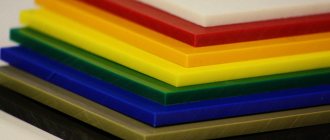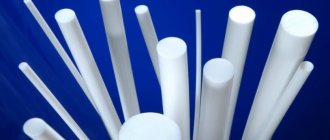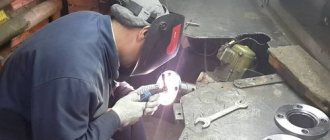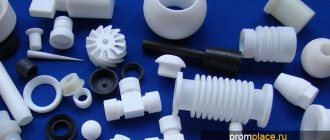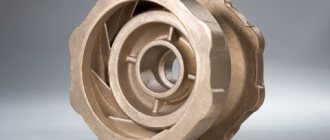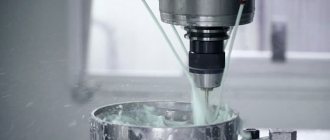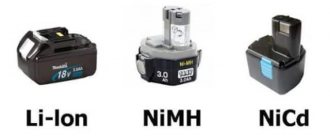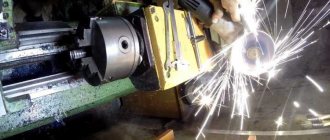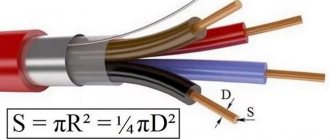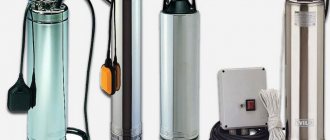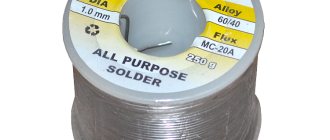For a long time, polymer materials have been widely used in various industries, medicine, pharmacology and for household purposes. Due to their good mechanical and electrical insulating properties, resistance to aggressive environments and durability, polymers have established themselves as universal materials. They successfully replace “traditional” structural materials (steel, bronze, etc.) and are used for the manufacture of electrical insulation, protective coatings, etc.
For domestic purposes, polymers are used as decorative and finishing materials and for various crafts. However, despite the large assortment, many polymers have similar properties, so we often face the problem of choosing the material most suitable for specific purposes and tasks. As an example, consider the differences between fluoroplastic and caprolon (polyamide PA-6). These materials practically do not differ in appearance and technical characteristics, which complicates the choice of which is better: caprolon or fluoroplastic . To understand this issue, let’s compare these materials and determine their advantages and disadvantages.
Choosing the right material.
But closer to the topic.
“Specialists” often choose materials for repairs not based on reference literature, but on inspiration and forums. We used reference literature and the experience of professionals. But even this approach did not save us from mistakes! Over the course of several years, we have found simply excellent material! OUR CHOICE! Anti-friction plastic. One of the options for Polyformaldehyde. Color white or black. In practice, it turned out to be the slipperiest of all the materials we tested. About them below. The glide is almost the same as that of fluoroplastic! When using it, the rack works as easily as in the original version! The material is hard and wear-resistant. Wear resistance is several times higher than the materials of the original bushings.
There was experience with the use of Caprolon (Polyamide 6) and TECAPET.
Caprolon (PA 6) extrusion . Very common in the form of round blanks. Sliding bushings are often made from it. In theory, it is less slippery than fluoroplastic, but can carry a much greater load. A few years ago we made our bushings from it. In practice (take note!), it glides poorly. When heated, it is very bad, and a sticking effect occurs when touched. It's all due to the addition of a plasticizer. In addition to the basic PA6, we tried graphite- and oil-filled. We strongly do not recommend all these materials.
Castable caprolon (PA 6) with the addition of graphite. With the same name, it has parameters that significantly distinguish it from extruded Kaprolon. Material color – black. The material is slippery, hard, wear-resistant. For some time we produced bushings using casting on our own equipment. But the details were not in demand. Therefore, production was stopped.
Polyethylene terephthalate (Tecapet) . The color of the material is light gray. In practice, it has a coefficient of friction less (that is, it is more slippery) than extruded Kaprolon, but more than cast Kaprolon (that is, it glides better). As the temperature increases, the friction coefficient increases slightly, but no obvious adhesion effect is observed. Very wear-resistant material. The vehicle mileage on it has exceeded 60,000 km, and its service life is 3 years.
They are also trying to use Bronze and Fluoroplastic.
Bronze. An excellent anti-friction material when paired with steel and in the presence of lubricant. But! Achieving the required clearance along the entire length, which is 0.01-0.02 mm, is possible only with a perfectly straight, round and cylindrical horizontal shaft. Otherwise, it will dangle somewhere and jam somewhere. And two different metals knock loudly against each other. Therefore, the idea of bronze did not find much distribution.
Fluoroplastic. Unique anti-friction material! Has a friction coefficient less than that of ice! But! At medium and high specific pressures it begins to deform (change shape, size, flow). Some use this disadvantage as an advantage. In order not to make exact measurements, these resourceful people make the sleeve a little larger on the outside and a little smaller on the inside. Install the bushing into the housing and press the shaft into the bushing. Fluoroplastic is pressed like plasticine and takes the desired shape and size. And this whole structure even works. Until the first good pit. Bang! Hit! The bushing changes from round to oval. But adherents of this material stubbornly stand their ground!
Source
Fluoroplastic or caprolon
Fluoroplastic or caprolon, which is better - this question often arises when choosing a material, when it is necessary to manufacture the required parts or parts of a mechanism. These polymers are very similar in appearance; they are used for the manufacture and replacement of metal bushings, friction pairs, gaskets, spacers, sealing collars, bearings, rollers, wheels, gears, piston rings, since caprolon and fluoroplastic structurally have high-tech and unique properties, often prevailing over metals.
Both polymers belong to modern structural materials, designed mainly to replace parts made of metals and alloys. The active development of technology in the chemical industry has made it possible to produce fluoroplastic and caprolon (polyamide), which replace heavy, bulky parts made of steel, metals and alloys that are constantly subject to corrosion and require maintenance and repair. Fluoroplastic and caprolon cope with this role with great success, thanks to their numerous predominant properties, while reducing operating costs, repair costs and extending the service life of machines, machines, and mechanisms. To select a material and make a decision, first of all, it is necessary to take into account the physical, mechanical, chemical properties of fluoroplastic and caprolon, as well as the conditions of their operation.
Processing Features
Caprolon processing is possible on milling, turning, drilling and grinding machines. During turning work, it must be remembered that this material has a low melting level.
During long-term machining, it is recommended to use carbon steel tools and tungsten tips.
Caprolon sheets or bushings stored for a long time in the cold cannot be immediately processed on machines. They must be moved indoors for 5 days so that the temperature in the material becomes the same.
It is worth noting that parts made from caprolon have a service life 1.5 times longer compared to parts made from other materials. The cost of producing parts from such polyamide is significantly lower compared to metal parts. Caprolon from polyamide 6 allows the production of parts with low cost, high strength and low labor intensity.
What is the difference between caprolon and fluoroplastic?
The differences between caprolon and fluoroplastic are not entirely noticeable at first glance, especially for an inexperienced person. Externally, these materials have a smooth surface and a color ranging from white to light cream, but they can still be distinguished externally. The highest quality fluoroplastic is almost white, dense, uniform in color, very slippery to the touch (similar to snow-white soap), when struck it makes a dull sound, it can be easily scratched, and a mark remains if pressed with a fingernail. Caprolon (polyamide) is creamier in color, less slippery, hard (no marks remain when pressed with a fingernail), and if you tap on it, the sound will be loud. The weight of fluoroplastic is twice (
Caprolon and fluoroplastic differences in properties
In addition to external differences, the properties of caprolon and fluoroplastic also differ, which affect the operation of the products. Let's consider the basic properties of caprolon and fluoroplastic, which can help with the choice of material for the manufacture of parts.
Melting point of caprolon and fluoroplastic, operating temperature.
Fluoroplastic has a wider operating temperature range from -269°C to + 260°C, caprolon from -40°C to +100°C, short-term -100°C to +170°C. Moreover, fluoroplastic, unlike caprolon, does not melt or burn, but goes into a fluid state at +327°C, the melting point of caprolon is within +215°C +225°C in its various modifications.
Friction coefficient with and without lubrication.
Determines the antifriction properties of fluoroplastic and caprolon, the ability for smooth movement of mating parts. Fluoroplastic is a more slippery polymer and its coefficient of friction is lower than that of caprolon. For fluoroplastic, the coefficient of friction without lubrication is 0.02, with lubrication 0.04; while for caprolon the friction coefficient is several points higher: from 0.20 to 0.33. Thanks to this low coefficient of friction, parts made of caprolon or fluoroplastic can be used where lubrication is undesirable, for example, in the food, textile or pharmaceutical industries; They can also be installed in hard-to-reach places where maintenance and lubrication are difficult or impossible. Note: Fluoroplastic and caprolon interact positively with any organic and synthetic lubricants.
Water absorption, or hygroscopicity.
Ability to absorb water. The hygroscopicity of fluoroplastic is zero; it does not absorb moisture in any form at all, even steam. Water absorption of caprolon, its saturation with moisture is possible up to 2% of its mass within 24 hours, and up to a maximum of 7% (depending on the method of production of caprolon and its modification, in our warehouse we sell caprolon polyamide PA 6 of the highest quality cast, produced by anionic polymerization) .
Hardness of caprolon and fluoroplastic.
What is stronger, harder, stronger, fluoroplastic or caprolon - the answers to these questions are given by experimental tests, reflected in GOSTs and TUs. Control tests are carried out on samples to determine the Brinell hardness of the material, or the hardness when a metal ball is pressed into the material. Caprolon has a hardness of 160-200 MPa, the hardness of fluoroplastic is much lower, 29.4-39.2 MPa.
The performance properties of caprolon, fluoroplastic and their modifications are given in more detail in the table.
Properties of caprolon, fluoroplastic, their modifications, data based on GOST and TU
| Index | Kaprolon | Fluoroplastic | ||||
| PA 6 | PA 6-MG | PA 6-MDM | F-4 | F4K20 | F4K15M5 | |
| Density, kg/m³ | 1150-1160 | 1150-1170 | 1140-1160 | 2140-2260 | 2050 | 2100 |
| Breaking tensile stress, MPa | 70-80 | 65-80 | 70-85 | 11,8-14,6 | 13,7-17,1 | |
| Relative extension, % | >20 | 10-30 | >25 | 300-350 | 65 | 150 |
| Stress at relative compressive strain equal to 25%, MPa | 120-130 | 120-140 | 120-140 | |||
| Stress at 10% deformation, MPa | 21,5 | 20 | ||||
| Deformation under load 10 MPa (24h, 22°C), % | 2,9-3,0 | 3,5-4,0 | ||||
| Friction coefficient for steel | 0,23-0,33 | 0,20-0,25 | 0,20-0,25 | 0,02 | 0,14-0,30 | 0,1-0,39 |
| Hardness when indenting the ball, MPa | 160-180 | 170-200 | 160-180 | 30-40 | 49-53,8 | 49 |
| Impact strength without notch, kJ/m², not less | 120 | 40 | 120 | |||
| Notched impact strength, kJ/m², not less | 3 | 4 | 3 | |||
| Specific impact strength, kgf*cm/cm² | more than 100 | |||||
| Modulus of elasticity in compression, MPa | 686 | 805 | 800 | |||
| Tensile modulus of elasticity, MPa | 686 | 1500 | ||||
| Compressive strength, kgf/cm² | 120 | |||||
| Tensile strength, kgf/cm² | 200-300 | |||||
| Ultimate strength during static bending, kgf/cm² | 110-140 | |||||
| Modulus of elasticity in bending (at 200°C), kgf/cm² | 4700 | |||||
| Melting point, °C | 220-225 | 215-225 | 220-225 | 327 | ||
| Operating temperature range, °C | -60°C +120°C | -60°C +120°C | -60°C +120°C | -269°C +260°C | -60°C +250°C | -60°C +250°C |
| Thermal stability at 415°C, h | not less than 110 | |||||
| Decomposition temperature, °C | above 415 | |||||
| Glass transition temperature, °C | -120 | |||||
| Bending temperature under load at a stress of 1.8 MPa, °C | 80-100 | 80-100 | 80-100 | |||
| Heat capacity, cal/g °C | 0,25 | |||||
| Thermal conductivity coefficient at room temperature, W/m deg. | 0,30-0,35 | 0,37-0,50 | 0,30-0,40 | |||
| Thermal conductivity coefficient, W/(MK) | 0,23 | 0,29 | ||||
| Thermal conductivity, kcal/m, h°C | 0,2 | |||||
| Specific heat capacity, J/(kgK) | 0,71 | — | ||||
| Vicat heat resistance, °C | 110 | 145-160 | — | |||
| Average coefficient linear thermal expansion by 1°C in the temperature range -50°C to 0°C | 6,6*10 -5 | 6,6*10 -5 | 2,8*10 -5 | |||
| Average coefficient linear thermal expansion by 1°C in the temperature range 0°C +50°C | 9,8*10 -5 | 9,8*10 -5 | 4,0*10 -5 | |||
| Coeff. linear expansion by 1°C in the temperature range -60°C +20°C | 8*10 -5 — 25*10 -5 | 8*10 -5 — 11*10 -5 | — | |||
| Coeff. linear expansion by 1°C in the temperature range +20°C +250°C | 8*10 -5 — 25*10 -5 | 11*10 -5 — 18*10 -5 | — | |||
| Electric strength | 20-25 kV/mm | — | 20-25 kV/mm | not less than 25*106 V/m | ||
| Specific surface electrical resistance, Ohm | 1*10 12 -1*10 13 | 1*10 11 -1*10 13 | 1*10 12 -1*10 13 | at least 10 17 | ||
| Specific volumetric electrical resistance, Ohm*m | 1*10 13 -1*10 14 | 1*10 11 -1*10 13 | 1*10 13 -1*10 14 | 10 17 -10 20 | ||
| Dielectric loss tangent at a frequency of 10 6 Hz | 0,015-0,025 | 0,020-0,030 | 0,015-0,025 | |||
| Dielectric loss tangent at a frequency of 10 3 Hz | 0,0002-0,0003 | |||||
| Dielectric constant at frequency 10 6 Hz | 3,3-3,5 | 3,5-4,0 | 3,3-3,6 | |||
| Dielectric constant at frequency 10 3 Hz | 1,9-2,2 | |||||
| Arc resistance, sec | 250 | |||||
| Limit PV, kPa m/s, at V=0.05 m/s | 490 | 588 | ||||
| Limit PV, kPa m/s, at V=0.5 m/s | 687 | 687 | ||||
| Limit PV, kPa m/s, at V=5 m/s | 1078 | 1078 | ||||
| Wear rate, g/h, no more | 2,0*10 -3 | 0,8*10 -3 | ||||
| Content of extractable substances, %, no more | 2,0 | 2,0 | 2,0 | |||
| Water absorption over 24 hours, % | 1,5-2,0 | 1,0-1,5 | 1,0-1,5 | 0,03 | — | |
| Maximum water absorption,% | 6,0-7,0 | 6,5-7,0 | 6,0-7,0 | |||
Fluoroplastic and caprolon differences in characteristics
Let's consider the differences between caprolon and fluoroplastic when choosing a material for the manufacture of parts:
Give preference to fluoroplastic if it is important for you that the part:
withstands the highest possible temperatures;
was capable of self-lubricating;
could work in a complete vacuum;
had the highest dielectric characteristics.
Choose caprolon if you have the following requirements for the product:
the product must withstand heavy loads, compressive and tensile forces;
resistance to high extreme impact loads.
Based on these data and operating conditions, you can make a choice in favor of one or another polymer, depending on the characteristics important for a particular case.
Source
WHAT IS BETTER: PTFE OR CAPROLON
For a long time, polymer materials have been widely used in various industries, medicine, pharmacology and for household purposes. Due to their good mechanical and electrical insulating properties, resistance to aggressive environments and durability, polymers have established themselves as universal materials. They successfully replace “traditional” structural materials (steel, bronze, etc.) and are used for the manufacture of electrical insulation, protective coatings, etc.
For domestic purposes, polymers are used as decorative and finishing materials and for various crafts.
However, despite the large assortment, many polymers have similar properties, so we often face the problem of choosing the material most suitable for specific purposes and tasks. As an example, consider the differences between fluoroplastic and caprolon (polyamide PA-6). These materials practically do not differ in appearance and technical characteristics, which complicates the choice of which is better: caprolon or fluoroplastic . To understand this issue, let’s compare these materials and determine their advantages and disadvantages.
Fluoroplastic-4: properties and scope
Fluoroplastic is produced by polymerization of fluorine-containing ethylene derivatives. As a result, a semi-finished powder product is obtained for the manufacture of various parts and integral structures. At the first stage of production, a melt is prepared from polymer powder with the addition of catalysts, hardeners and various additives. Then finished products are produced using the injection or extrusion method. The industry mainly produces fluoroplastic in the form of sheets, blocks and rods. This polymer lends itself well to any type of mechanical processing, which makes it possible to obtain not only simple-shaped products, but also complex three-dimensional structures.
The physicochemical properties of fluoroplastics depend on the number of fluorine atoms. However, all of them are characterized by:
- Resistance to aggressive environments, corrosion and radiation;
- Resistance to high temperatures;
- Wear resistance;
- Plasticity and fluidity;
- Durability;
- Electrical insulating properties;
- High strength;
- Good machinability.
Fluoroplast-4 is characterized by abrasion resistance, heat resistance and high electrical insulating properties, but has fluidity and low strength compared to other brands. Fluoroplastics are used in mechanical engineering, automotive, chemical, food and other industries. These polymers are used to make pistons, bearings, electrical insulating gaskets, structural elements of containers for chemical reagents and other products.
Polyurethane
It is a polymer with high elasticity and viscosity . It's resilient. Some types of it stretch to sizes that are many times larger than the original, and then easily return to their previous shape.
Polyurethane in its chemical formula contains molecules of a substituted and/or unsubstituted urethane group, as well as many other compounds.
The properties of this substance depend on the structure, chemical composition, and length of the polyurethane chain. It can be a viscous liquid, plastic or crystalline solid. Have the properties of rubber or hard plastic.
- Withstands force loads and mechanical processing well.
- Resistant to temperature changes, withstands – 60 o C and + 80 o C.
- Does not conduct electricity.
- Highly elastic.
- It is not destroyed by ozone, acids, oils, or solvents.
- Wear-resistant.
Polyurethane is used for the production of structural, insulating, and anti-friction parts in various industries. Included in glue, paints and sealants. These are raw materials for the production of equipment parts, machines, bushings, and sports tires. Sheets, bushings, rods are the main forms of solid polyurethane products.
Caprolon: properties and scope
Caprolon or polyamide PA-6 refers to heat-resistant polymeric materials obtained from chemical compounds containing amide groups. Caprolon is produced by polymerization of the feedstock in the presence of catalysts, stabilizers and other additives. As a result, a pale yellow or white powder is obtained, from which a melt is then prepared for the manufacture of polymer products using the injection or extrusion method. Caprolon is produced in the form of sheets and rods of various diameters. This material lends itself quite well to mechanical processing, welding and gluing, which makes it possible to produce parts of varying complexity and finished products of various shapes from caprolon.
Caprolon has the following physical and mechanical properties:
- Resistance to wear and abrasion;
- Atmospheric and moisture resistance;
- Good insulator;
- Good mechanical strength;
- Can be machined;
- Resistant to chemicals.
Caprolon is widely used in mechanical engineering, light industry, construction, medicine and for household purposes. Pipe fittings, insulating gaskets, and also anti-corrosion and other types of protective coatings are made from it.
Receipt
To obtain high-density caprolon, it is necessary to carry out a low-temperature polymerization reaction, in which aminocaproic acid, alkaline catalysts and activators will take part.
The resulting material can be diluted in phenolic and cresol solutions. This material is considered an excellent dielectric.
According to the state standard, this polyamide must be manufactured in accordance with the requirements of GOST 7850-86. “Caprolon. Technical conditions".
Caprolon or fluoroplastic – which is better in the end?
To compare caprolon and fluoroplastic and choose which is better, we will use a table that shows the main technical characteristics of these materials:
| Indicator name | Indicator value | |
| Ftoroplast-4 | Kaprolon PA-6 | |
| Color | from light yellow to white | white or yellowish |
| Release form | rods, sheets, blocks | rods, blocks |
| Density of material, kg/m3. | 2100 – 2200 | 1150 – 1160 |
| Operating temperature range, °C | –269 … +260 | – 30 … +110 |
| Thermal conductivity coefficient, W/m°C | 0,25 | 0,3 |
| Water absorption,% | 0,0 | 1,5 – 2 |
| Tensile strength, MPa | 20 – 30 | 80 – 90 |
| Ultimate compressive strength, MPa | 12 – 15 | 100 – 110 |
| Elongation at break, % | 350 | 600 |
| Brinell hardness, MPa | 30 – 40 | 160 – 180 |
| Electric strength, kV/mm | 50 | 30 – 35 |
| Dielectric constant at 1 MHz frequency | 0,002 | 3,3 |
| Dielectric loss tangent at a frequency of 1 MHz | 0,2 – 03 | — |
| Coefficient of sliding friction on steel in lubricant | 0,02 | 0,06 – 0,08 |
| Coefficient of sliding friction on steel without lubrication | 0,2 | 0,2 – 0,3 |
| Abrasion resistance | high | very high |
Differences
As can be seen from the table, caprolon or fluoroplastic have practically no differences in appearance , but in physical and mechanical properties they have quite significant differences. Therefore, when choosing a polymer, you should pay attention to the following criteria:
- Mechanical strength and hardness;
- Electrical insulating properties;
- Resistance to abrasion and wear;
- The magnitude of the sliding friction coefficient.
In terms of strength characteristics, caprolon is stronger than fluoroplastic , but is somewhat inferior to it in hardness and workability. Caprolon is more resistant to abrasion and wear and works better under long-term loads. The electrical insulating properties of the materials differ slightly.
It is also worth paying attention to the cost of materials. The price of caprolon is from 250 rubles. for 1 kg, and fluoroplastic - from 500 rubles. Thus, when comparing caprolon and fluoroplastic and choosing which material is better, we start from the following criteria: for working in difficult conditions and mechanisms with increased wear of parts, it is preferable to use caprolon, and in conditions of exposure to chemically aggressive environments and elevated temperatures, fluoroplastic performs better.
Source
Which one is better?
There is much in common between caprolon and fluoroplastic, for example, they are both harmless and can be used in the medical and food industries. It is difficult to distinguish them by external signs; they are resistant to chemical elements.
Compared to fluoroplastic, caprolon is less wear-resistant, so it will last less, and also caprolon has a lower coefficient of friction , it is 0.2-0.3, and for fluoroplastic -0.2. To make bushings from caprolon, the part must be processed with an accuracy of hundredths of a millimeter. Fluoroplastic is a softer material; when pressed, marks in the form of small dents may remain. Caprolon is harder and makes a dull sound when struck.
Both materials have excellent characteristics, and which one is better will depend on where and for what purpose they are used.
Source: stanok.guru
